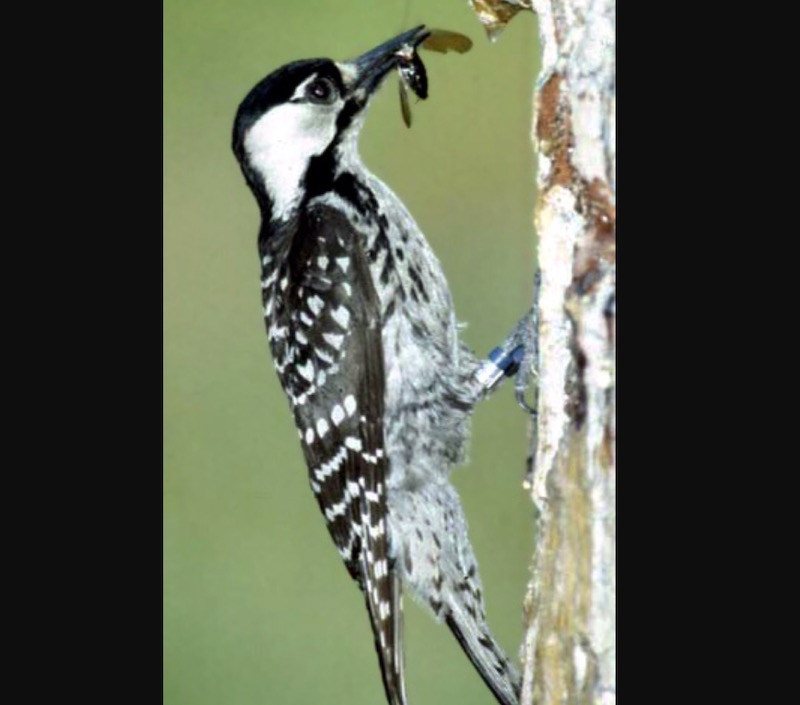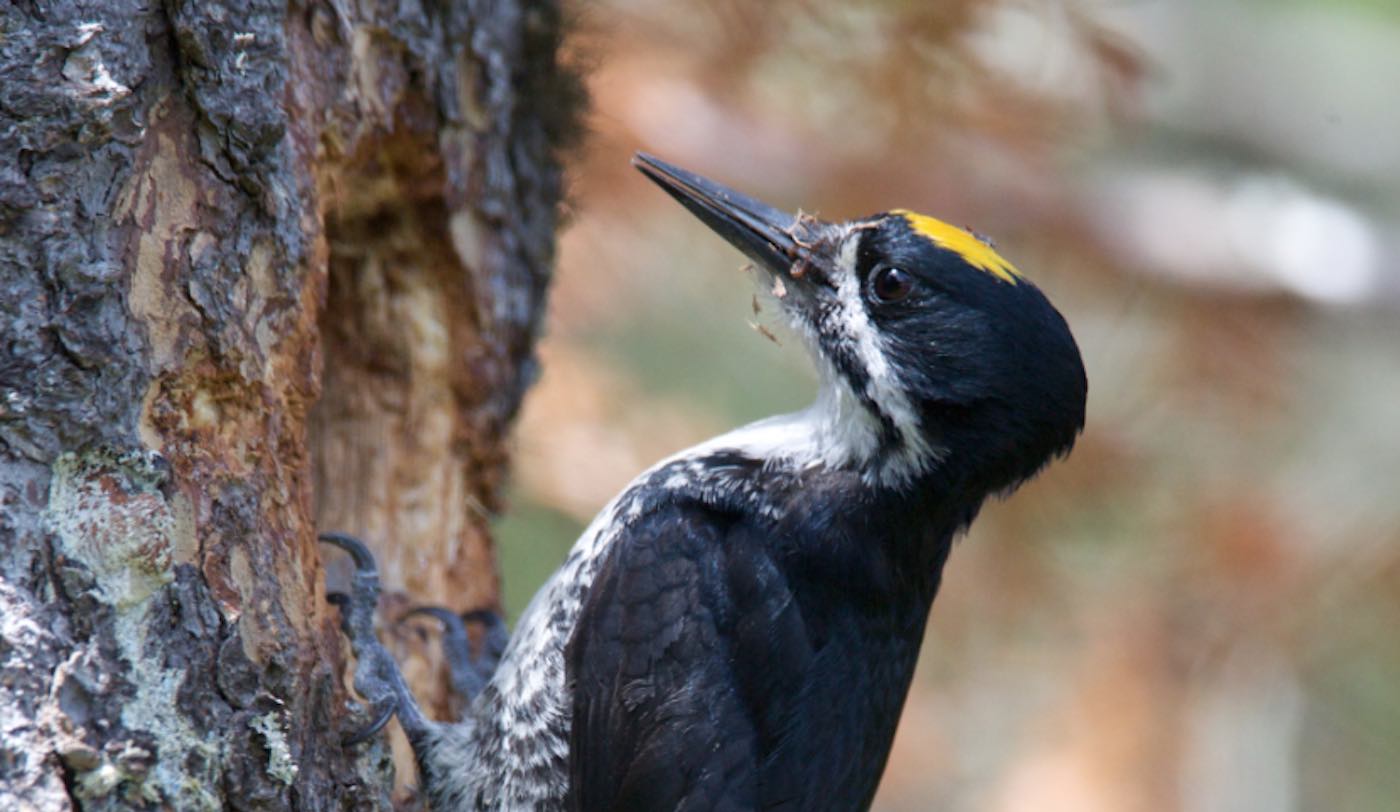(Andy Corbley) It’s hard to imagine that the infernos burning in the Sierra Nevada and Cascade mountain ranges in California and Oregon would be good for anything—but for the native black-backed woodpecker it’s the best of times, and necessary for them to continue their transformative practices on the forest.
by Andy Corbley, September 20th, 2020
Relentlessly drilling holes in the sides of fire-hardened trees in pursuit of insects, they create ready-made shelters for dozens of different animal species, who eat fire-retardant plants seeds and distribute them hither and yon in their droppings; thus allowing the forest to regenerate.
This amazing avian is just one of an entire web of plant and animal species who have evolved around the necessity of seasonal fires. The woodpecker deliberately seeks fire-damaged forests out in search of their favorite food: the larvae of the black fire beetle, which have evolved heat-sensing organs to find which trees are still warm from fires to lay their eggs in.
Indeed both of these species have evolved to interact with the pine forests of the Northwestern United States, where the trees have thick coatings of resin-soaked bark that protect them from high-intensity blazes.
“Woodpeckers are ecosystem engineers,” Teresa Lorenz tells National Geographic. A wildlife biologist with the U.S. Forest Service’s Pacific Northwest Research Station in Olympia, Washington, she has tracked black-backed woodpeckers in the forests of the Cascade Range, where this year’s fires have burned catastrophically.
“Many small animals, from chipmunks to flying squirrels to mountain bluebirds and wood ducks, compete for the woodpeckers’ vacated nests because they are so protected from the elements and other predators. We wouldn’t have swallows, swifts, or bats without woodpeckers.”
Another fire-pecker
Out of 180 species of woodpecker on earth, the black-backed is not the only one who has adapted to thrive in fiery forests.
The red-cockaded woodpecker is a fire specialist living in the opposite corner of the US from the black-backed, and relies on low-intensity burns through the undergrowth of the longleaf pine forests of the southeast and mid-Atlantic.
This fire-loving woodpecker almost disappeared after clear-cut logging reduced its home range—from Texas in the west, to Florida in the south, to New Jersey in the north—to just 3% of its original forest cover.
But like a phoenix bird rises from the ashes, its listing as one of the first additions to the Endangered Species Act saw the red-cockaded come back from a population collapse that most scientists concurred would have led to its extinction.
 39 separate recovery populations have increased their numbers by 40%, and an updated recovery plan is being formulated with the aim of a potential removal from the list.
39 separate recovery populations have increased their numbers by 40%, and an updated recovery plan is being formulated with the aim of a potential removal from the list.
A housing-sector collapse
Like the black-backed woodpecker, the red-cockaded population creates thousands of nesting cavities in trees, which all manner of animals compete to occupy after the bird abandons them.
To date, 27 species of vertebrates as well as many invertebrates, have been found living in the small hollows. With the collapse of the red-cockaded population, the longleaf pine forests experienced a real estate crisis.
This is compounded by the fact that this particular woodpecker creates their hollows in living, not dead, trees a task that requires immense time and labor such that the bird will leave the nest to its descendants much the way humans do with their houses, and therefore don’t produce more than a few in their lifetime.
This arduous task requires a particular tree, and males and their offspring have been known to continuously inhabit the same tree hollow for 30 years. The typical tree is a pine of 75-years or older — large enough to contain a hollow for several birds.
These kinds of trees grow in forests created by low-intensity fires—the kind that were deliberately set by Native Americans hundreds of years ago, and the kind which forest managers today have had to set as part of the red-cockaded’s recovery plan, which also included drilling artificial nesting holes which they would almost always occupy.
This discovery, made in the 80s by scientists at Virginia Polytechnic Institute, would become an invaluable strategy after Hurricane Hugo obliterated 90% of the longleaf pine forests in South Carolina’s Francis Marion National Forest.
Like a woodpecker version of Katrina, 475 breeding woodpecker couples lost their homes. To give them a helping wing, the Forest Service drilled 2,800 holes in remaining trees.
“South Carolina now has over 1,400 clusters of woodpeckers,” reads a report on Hugo and the woodpecker effort from the FWS. “Where there were 1,900 cavity trees prior to Hugo, there are 5,800 today. Areas of the state that haven’t seen birds in over four decades now have them moving in.”
They will always need prescribed burns and artificial nesting holes, but the red-cockaded woodpecker, like the black-backed, are examples of how resilient nature is, and that even a blazing forest inferno is used by species to flourish, whether for food or shelter.
About The Author
Andy Corbley is the founder and editor of World At Large, a small environment, travel, and lifestyle focused journal that stresses integrity, nuance, and honesty which launched in early March 2019.
Stillness in the Storm Editor: Why did we post this?
The news is important to all people because it is where we come to know new things about the world, which leads to the development of more life goals that lead to life wisdom. The news also serves as a social connection tool, as we tend to relate to those who know about and believe the things we do. With the power of an open truth-seeking mind in hand, the individual can grow wise and the collective can prosper.
– Justin
Not sure how to make sense of this? Want to learn how to discern like a pro? Read this essential guide to discernment, analysis of claims, and understanding the truth in a world of deception: 4 Key Steps of Discernment – Advanced Truth-Seeking Tools.
Stillness in the Storm Editor’s note: Did you find a spelling error or grammatical mistake? Send an email to [email protected], with the error and suggested correction, along with the headline and url. Do you think this article needs an update? Or do you just have some feedback? Send us an email at [email protected]. Thank you for reading.
Source:

Leave a Reply